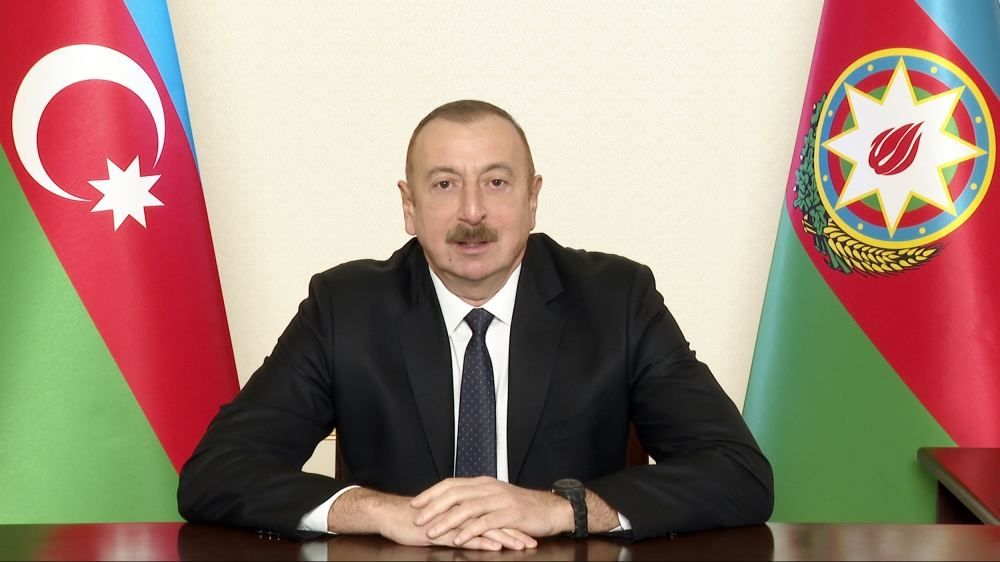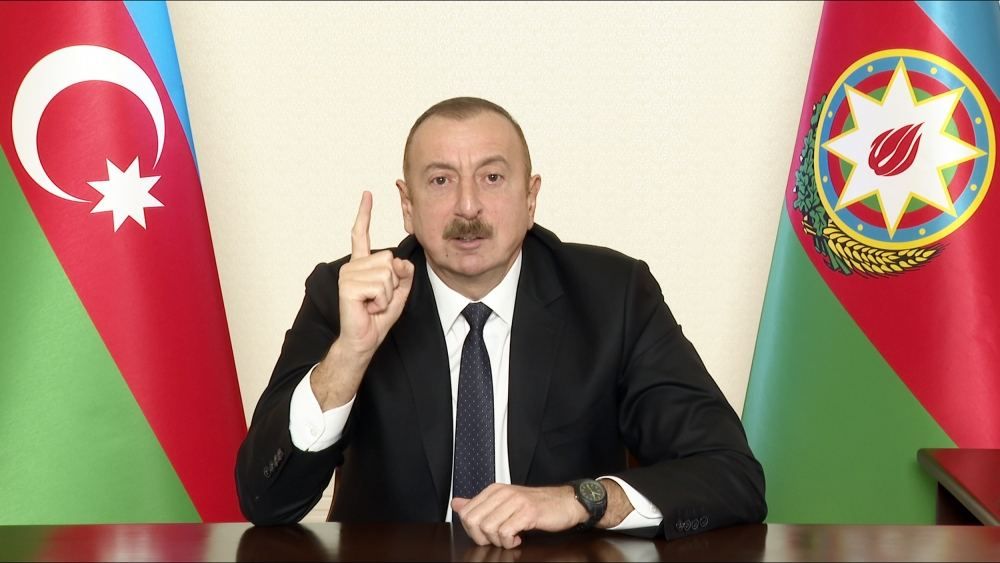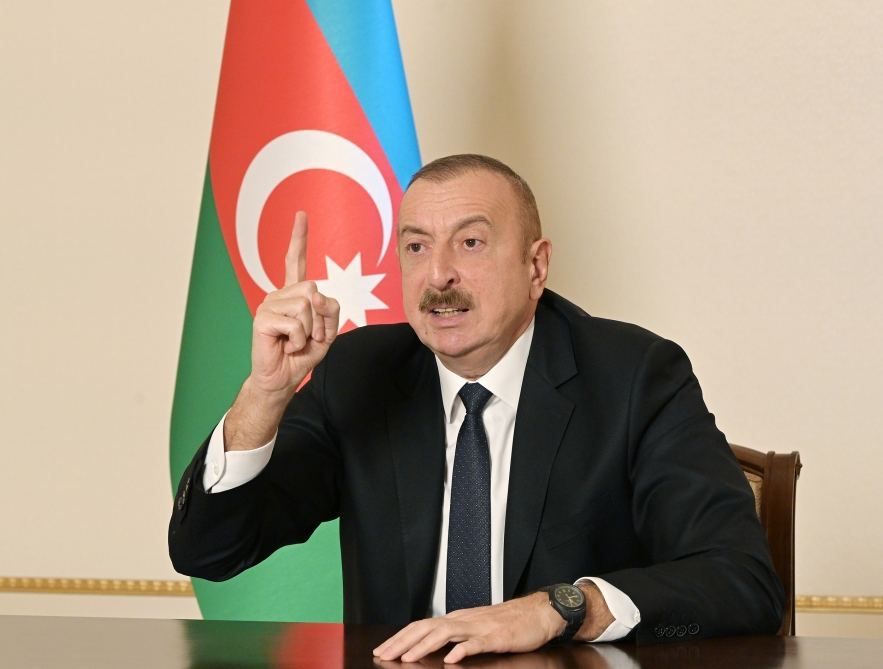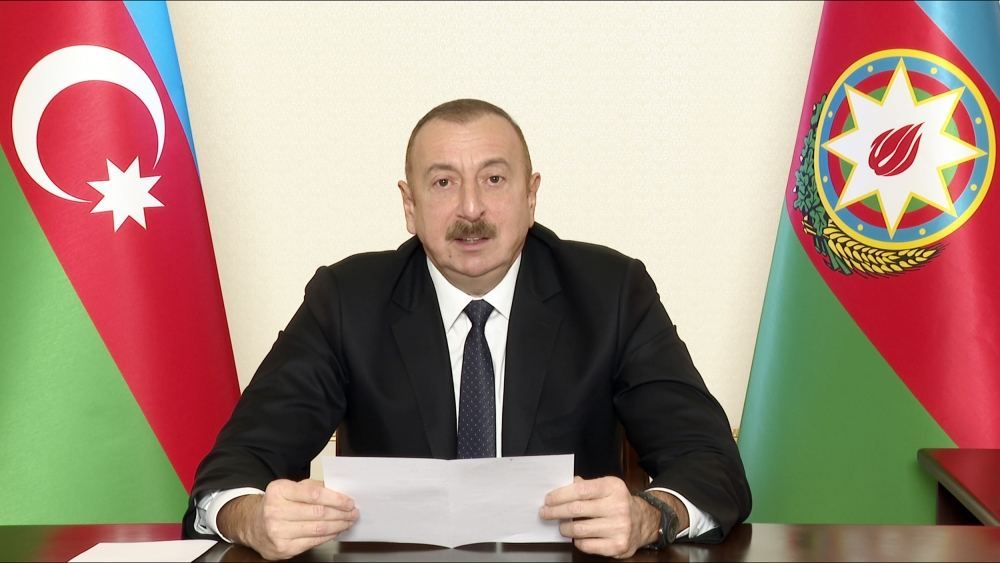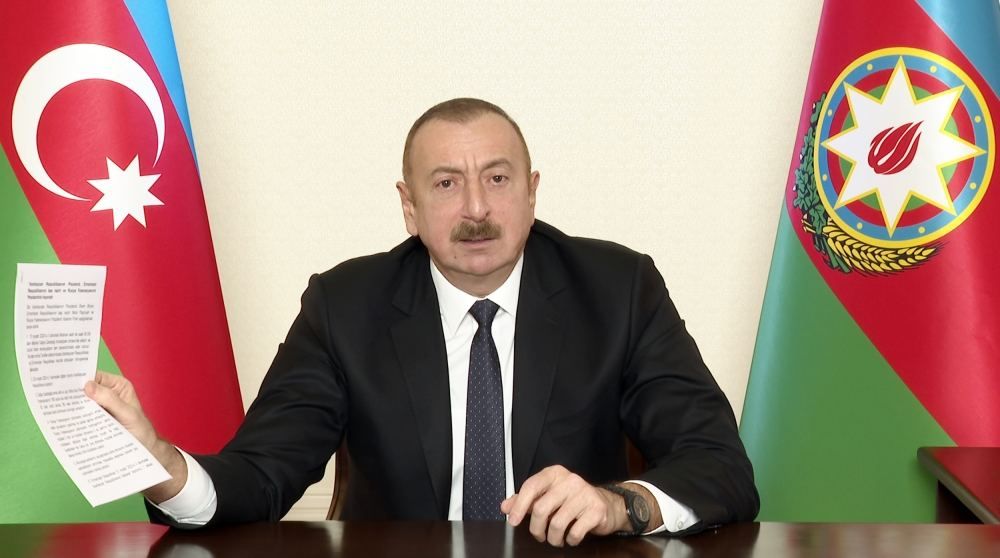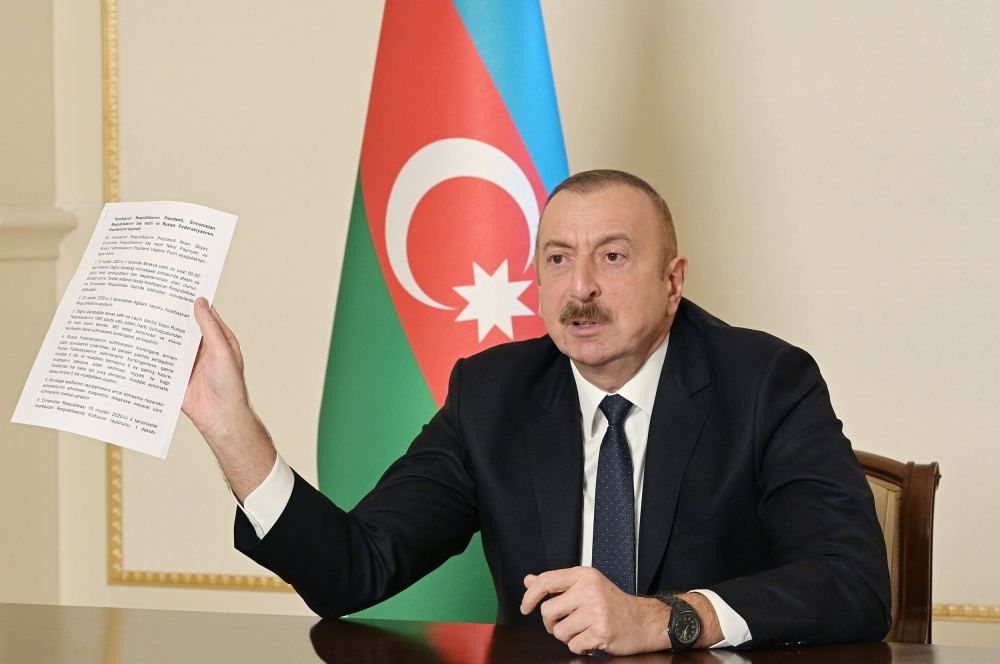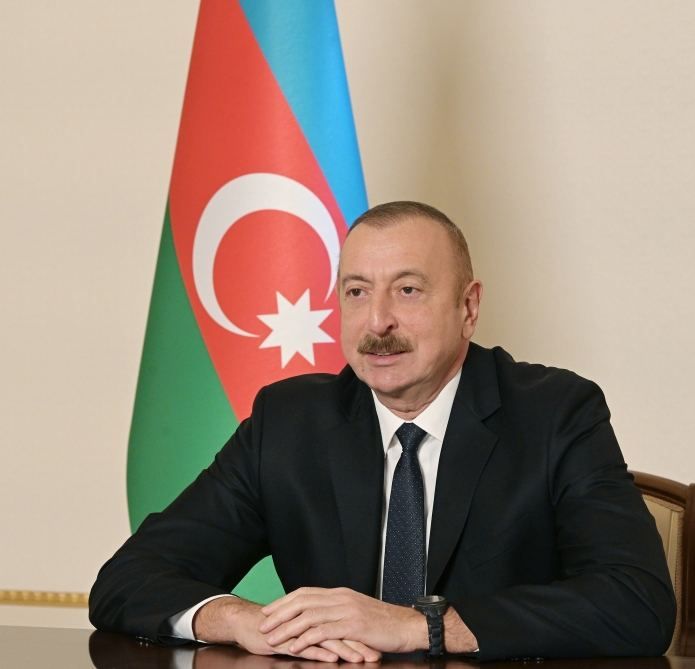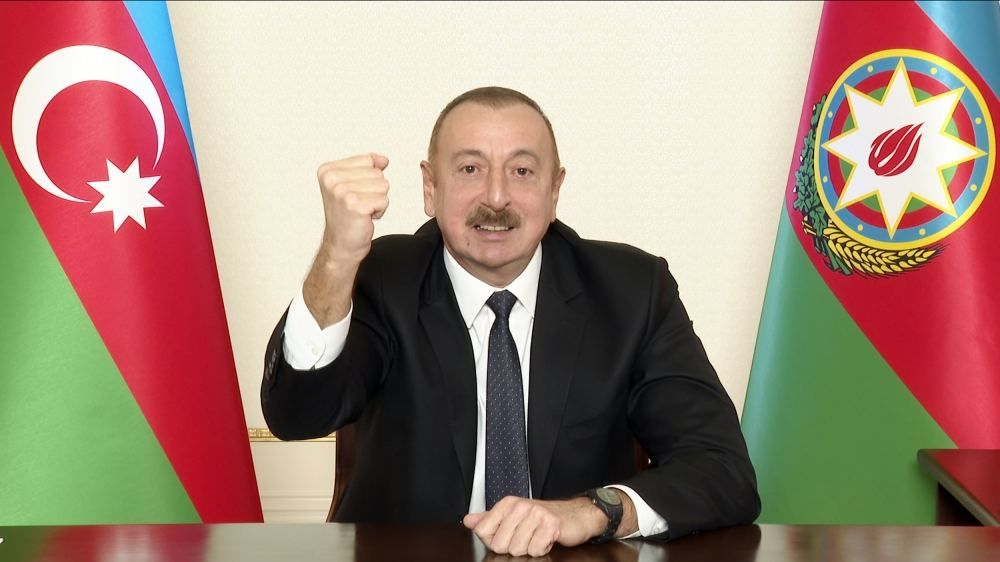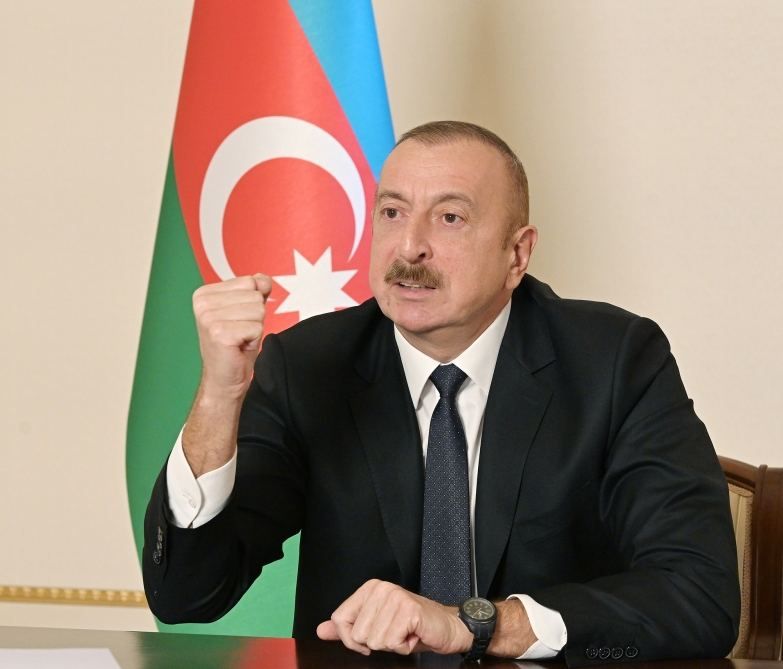Chronicles of Victory: President Ilham Aliyev addresses the nation due to liberation of Lachin on December 1, 2020 [PHOTO]
![Chronicles of Victory: President Ilham Aliyev addresses the nation due to liberation of Lachin on December 1, 2020 [PHOTO]](https://www.azernews.az/media/2022/12/01/prezident_muraciet_011220_1.jpg)
By Trend
President of the Republic of Azerbaijan Ilham Aliyev has addressed the nation on December 1, 2020.
Trend presents the address.
Address of President Ilham Aliyev to the nation
- Dear fellow countrymen,
It is with great joy that I inform you that the Lachin district has been liberated from occupation. I cordially congratulate all the people of Azerbaijan on this occasion. The liberation of the Lachin district from occupation is a historic event. Moreover, we have returned to the Lachin district without firing a single shot. We have forced the enemy to do this. The bright victory won on the battlefield has led to this remarkable result – three of our districts, Aghdam, Kalbajar, and Lachin, have been returned to us. We have returned these districts without firing a single shot and without a single martyr.
Lachin district is one of our biggest districts. It covers an area of 1,800 square kilometers. The rich nature of the Lachin district, its historical sites, and underground riches are our national treasures. Lachin district will play an important part in the future economic development of Azerbaijan. First of all, we will return Lachin to the people of Lachin. I sincerely congratulate dear residents of Lachin on this wonderful event. When Lachin was occupied, just over 50,000 people lived in it. Today the population of Lachin district has reached 80,000 people. Of course, one of our main goals will be to return the residents of Lachin there as soon as possible. We will also try to return the former internally displaced persons to all other districts liberated from the occupation as soon as possible.
Of course, the situation on the lands liberated from the occupation foreshadows great difficulties. Everything is destroyed there – the infrastructure is destroyed, buildings are demolished, administrative buildings are demolished. There are currently no living conditions in these places. But we will restore these regions, all our districts, we will take all steps to create a normal life for our citizens. As you know, the first projects have already started. Relevant funds have been allocated from the President's contingency fund. The construction of the Fuzuli-Shusha highway and the Barda-Aghdam railway has already begun. This shows that we plan this work as efficiently as possible and, at the same time, in a short time, so that to organize all these activities without wasting time. Relevant state bodies have already been set up and all this work will be carried out in a coordinated manner.
In Lachin district, we have large forest areas – 22,000 hectares of its territory is covered by forest. This is also our great asset. Kalbajar district has 24,000 hectares of forest. In Zangilan and Gubadli districts, there are 12,000 hectares. At the same time, Hadrut district and a part of Khojavand district liberated from occupation have large forest areas too. Forests are the lungs of our planet. The hated and savage enemy had been cutting down and plundering our forests for 30 years, and recently set them on fire. Despite this, most of our forests remain intact because the enemy could not get into these forests, as they are located in remote mountain ranges. Of course, the restoration of destroyed and ruined infrastructure, including the felled trees, will also be in the spotlight.
I must also say that our great river, the Hakari, which is more than 100 kilometers long, originates in the Lachin district. This is an issue of great strategic importance. I can say that more than 10 of our large and small rivers originate in the lands liberated from occupation. I would like to highlight four of them because the length of these rivers exceeds 100 kilometers. The Tartarchay, which is 200 kilometers long, the Bazarchay, which is about 180 kilometers long, the Khachinchay, which is about 120 kilometers long – these three rivers are located in Kalbajar district. The Hakari river is also one of our largest rivers, with a length of over 100 kilometers. This is very important because the sources of the main rivers passing through the territory of Azerbaijan are located in other countries. The sources of three of our main rivers, the Kur, the Araz, and the Samur, are located in other countries. Of course, the fact that the sources of four large rivers are located on the territory of our country gives us a great advantage. These territories were under occupation, but they have now been liberated from occupation. Of course, our water resources will be of great importance in restoring the lands liberated from occupation and for future life there. Relevant instructions have already been given and there are plans to build reservoirs there. This in itself is one of the factors that will have a great impact on the development of agriculture and building an environmental equilibrium.
The overall economic, agricultural and tourism potential of all the liberated districts is great. We must maximize this potential and turn the Karabakh region into one of the most beautiful regions not only in Azerbaijan, but also in the world, and I am sure that we will achieve this.
At the same time, the strategic importance of the Lachin district lies in the fact that the Lachin corridor runs through the territory of the district and through the city of Lachin. As you know, this corridor has been transferred under the control of Russian peacekeeping forces. For many years, the corridor was under the control of the Armenian armed forces, the occupiers. I can say that the initial version of the joint statement signed on 10 November contained a provision on keeping this corridor under the control of the Armenian armed forces. I opposed this and as a result, control over this corridor was transferred to Russian peacekeepers. I think this is a great achievement. The Lachin corridor has been cleared of Armenian occupying forces. I must also say that a lot of work was done on the initial version of the statement, especially after the liberation of the city of Shusha from the occupation. The initial version of the statement suggested that the width of the Lachin corridor should be 30 kilometers. I was categorically against this and said that these claims of the Armenian side were absolutely unfounded. There is no need for such a wide corridor to ensure security measures within the corridor. Therefore, I considered this proposal as being absolutely unacceptable and expressed my opinion. The second version envisaged the Lachin corridor as being 10 kilometers wide. I didn’t agree to that either, as a result of which agreement was reached on a corridor 5 kilometers wide. The 5km corridor is wide enough for us, for the Armenians living in Nagorno-Karabakh, and for ensuring security.
I should also say that the return of the Lachin district to Azerbaijan, especially the issue related to the Lachin corridor, has always been discussed as a very important and separate topic in the negotiations held over many years – for about 30 years. In general, the Armenian side believed that the entire Lachin district should be given to them as a corridor. Unfortunately, some Western circles supported this position, which made Armenia's position even more irreconcilable, and one can say that the enemy became completely impudent. As a result, a very serious policy of settlement was carried out in the Lachin district. The illegal settlement was also carried out in other places liberated from occupation, but not to the same extent, not in the same volume. For example, if we look at Aghdam, Fuzuli, Jabrayil, Zangilan, and Gubadli districts, there were more military units there. All the houses and buildings there were destroyed by the hated enemy. Servicemen, members of their families, and a small number of civilians used to live there. The Armenians brought from abroad were not sent there. Lachin district was very seriously taken under Armenian control and a very large settlement program was implemented there. Thousands of people lived there. According to some sources, about 10,000 people may have lived there. In other words, the Armenian leadership had no intention of returning the Lachin district to Azerbaijan. When topics related to the Lachin corridor were raised during the negotiations, both Armenia and its patrons always noted that, no, the Lachin district is a separate topic. Although we were not told this directly, there was always an opinion that the Lachin district should be retained by Armenia in some form.
In connection with the process of negotiations, I must also say – I want the Azerbaijani people to hear this information from me – that the issue of returning the occupied districts to Azerbaijan was the central topic of the negotiations for a reason. This was our position. But here, too, a phased solution was envisaged. We were also in favor of that. The return of five districts to Azerbaijan at the first stage, the return of Kalbajar and Lachin districts with the exception of the Lachin corridor at the second stage. Every time the Armenian side said that if these seven districts were returned to Azerbaijan, then the issue of status for Nagorno-Karabakh must be resolved at the same time. Another issue is that Armenia was simply engaged in imitating the negotiations and was not going to return a single district to us. But in any case, their position was that five districts could be returned, but in order to return Lachin and Kalbajar districts, Azerbaijan must recognize either the independence of Nagorno-Karabakh or the vote that would have taken place there, and the date of such a vote would have been determined. If Nagorno-Karabakh had been granted independence, then Armenia would have returned Kalbajar and Lachin districts to Azerbaijan, but the Lachin corridor would have been given to Armenia, and the width of this corridor was not determined. These issues were on the negotiating table.
I can say that over the past 17 years we have received repeated signals from various places, from outside circles that we should take five districts now and be content with it. We were told that we had been defeated in the war, that Armenia had won – the implication was the first Karabakh war. We were told to come to terms with this reality. The five districts we were being given were described as a big deal, while Lachin and Kalbajar were supposed to be left for later. We were also told that when we granted independence to Nagorno-Karabakh, then part of these districts could be transferred to us.
I always said that if Lachin, Kalbajar, and Shusha did not return to Azerbaijan, then there can be no agreement. My position irritated many in foreign countries. I was saying that our territorial integrity must be restored. I said that the military option is never ruled out. I not only spoke about that. For all these years, having mobilized our resources, we strengthened the country, gathered strength – gathered strength at the international level, within the country, in resolving economic issues, in strengthening the solidarity and unity in the country, and in army building. We have turned this strength into an iron fist, broken the enemy’s back, and created a new reality. If some were telling us to come to terms with reality a year ago, I say to them today that everyone should come to terms with the new reality. If someone wants to interfere with the statement signed on 10 November, they will be faced with our tough position. There are such attempts. They pursue one goal – to violate this agreement because it is very annoying for some due to a new security format emerging here. The statement reaffirms the establishment of a joint Turkish-Russian center. At the same time, some are annoyed by the security measures adopted here and the implementation of the provisions of the statement. However, no-one will be able to interfere in our affairs, and the agreement reached. It is being fulfilled and must be fulfilled.
I want to say again that we have created a new reality, won a victory, crushed the enemy, driven it out of our lands. Thus, we have created a new reality. Everyone will have to accept it, will have to come to terms with this reality, just as Armenia has done. There is Pashinyan's signature under this Statement. He did sign it. He was forced to sign it. In essence, he signed an act of capitulation. Armenia either had to be completely destroyed or sign it. What do others care about that? Let everyone mind their own business.
A new reality has emerged in our region. We have created it. Azerbaijan has created this reality. We have driven the enemy out of our lands. We have fulfilled the resolutions of the UN Security Council. These resolutions have remained on paper for 27 years. For 27 years, these resolutions have been a piece of paper for many – not only for Armenia but also for others. We said that international law is on our side and that resolutions of the UN Security Council require a withdrawal of the occupying forces from our lands. However, this had no result. We have created a new reality in international legal practices and in our region. We have fulfilled the resolutions of the UN Security Council. We have restored our territorial integrity. We have ended the occupation. I hope that we have organized a new format of security and cooperation in the region for the present and future. Life will show what this format will consist of. In any case, we have done everything necessary to create this new format of cooperation and expelled the enemy from our lands. If issues specified in the statement of 10 November are resolved, then a new cooperation framework will be created in our region.
Therefore, the return of the Lachin district to us is, of course, a historic issue. During the war, we liberated an area of about 5,000 square kilometers by military means. At the same time, we have returned the territory about the same size, about 5,000 square kilometers, peacefully. Of course, this cannot be described as a peaceful recovery. We have forced the enemy, who was already on the edge of the abyss and could have been completely destroyed. They had no other option – either to be completely destroyed or to sign an act of surrender. Look at our immense successes both in the military and political planes. Look at the thoughtful policy we have pursued over the years. In many cases, we could not inform the public about the details of this policy because it was confidential information, the disclosure of which could have affected the implementation of our plans. However, pursuing a very precise, focused, and consistent policy, we worked towards one goal. We had one goal – the goal of clearing our lands from the enemy. We have achieved it – both on the battlefield and at the negotiating table, through agreement. When I said that the issue has a military solution, I meant exactly that. If we had not defeated the enemy, they would never have left these lands of their own free will. The enemy wanted to perpetuate this occupation, and all their nefarious actions pursued this very goal. They gave Lachin district some ugly Armenian name. This name no longer exists, it has been thrown into the trash, it was thrown into the trash, like all the other ugly names of theirs.
The occupation of the Lachin district was a great tragedy. I want to say again that the occupation of any district was a tragedy, but the occupation of Lachin district allowed for overland communication between Armenia and Nagorno-Karabakh. The occupation of Lachin in May 1992, a few days after the occupation of Shusha, was a great loss for us. Armenia could already send weapons, ammunition, and manpower along this corridor. Of course, this led to great losses. About a year later, the Kalbajar district was occupied too.
It is possible to say that all this laid the foundation for the subsequent occupation. I would also like to say again that when the Lachin district was occupied, there was a struggle for power in Baku. Those who fought this struggle sold Lachin, Shusha, Kalbajar to the enemy, and, one might say, put the Azerbaijani statehood on the edge of a precipice. We remember all that history too well. The liberation of Lachin district today without a single shot being fired and without a single martyr is our great victory.
I want to say again – I have already spoken about this – we would have taken Lachin, Kalbajar, and Agdam anyway. We had plans and we were consistently moving towards them. But everyone should know that Kalbajar and Lachin districts have a very difficult natural terrain. The road to Kalbajar district that existed in Soviet times passed through Aghdara district. In Soviet times, this district was called Mardakert and the Armenians lived there. There was no other road, one might say. Now we have entered Kalbajar from Goygol and Dashkasan districts. We could have suffered heavy losses, especially in winter, given the difficult terrain. We could have suffered great losses in liberating Aghdam, Lachin, and Kalbajar districts. It would have taken a lot of time.
Therefore, our victory is a historic victory. We have liberated several districts from the enemy on the battlefield, returned three districts, and forced the enemy, thus resolving the Nagorno-Karabakh conflict. The Nagorno-Karabakh conflict is gone. If someone thinks that this conflict still exists, they are wrong. People living in Nagorno-Karabakh today are citizens of Azerbaijan. I want to say again that they will live better within a united Azerbaijani state. They will get rid of this poverty. Notice that we are currently building a railway from Barda to Agdam. The distance from Agdam to Khankandi is around 20-30 kilometers. How long will a trip from the capital of Armenia to Khankandi take – perhaps ten hours by truck. Moreover, this route lies through mountain roads. From Agdam to Khankandi, it will take half an hour.
This will precondition our future prospects. Therefore, we must be ready for this and build our strategy, take tactical steps so that there is no source of threat in this region anymore. The Azerbaijani army is the guarantor of this, of course. If we look at the geography of this region, then everyone can see that Armenia today is connected with Nagorno-Karabakh by a corridor 5 kilometers wide.
The Armenians living in Nagorno-Karabakh today and the Azerbaijanis who will definitely return there will live in the conditions of good-neighborliness again. There are logistical issues, transport issues, energy security. We will examine all of these issues. Unlike the Armenian leadership, we have a strategic vision and it has already been formed. We are consistently moving towards our goal. The leadership of Armenia had no vision even in relation to the Armenia-Azerbaijan Nagorno-Karabakh conflict. They did not know what they wanted themselves. They used to say that Nagorno-Karabakh was an "independent state". They used to say that "Nagorno-Karabakh is Armenia". How can these conflicting ideas be combined in one? What does this mean? It means that the leadership of Armenia consists of incompetent people who do not understand politics. Okay, if this is an independent state, then what is your army doing there? If it is an independent state which is not recognized by anyone, not even Armenia itself, then how is "Nagorno-Karabakh Armenia and full stop", quoting the Armenian prime minister? So they did not have a clear idea on this issue either. This is the country we were facing.
Of course, we see again, and while on the lands liberated from the occupation, I saw again that they did not want to return a single centimeter of land to us. Otherwise, they would not have invested so much there, so much money, they would not have built these fortifications. They wanted to keep these lands to themselves forever. This is why they concocted these fake maps. This is why they gave our cities their names. This is why they brought Armenians from abroad and placed them there. They committed war crimes and they will be held accountable for all their crimes. This work has already entered a practical phase. The assessment process will begin soon and the damage will be calculated. Steps have already been taken at the legal level. I can already tell the Azerbaijani people about this. I do not want to reveal details yet but this is no longer an intention, but practical steps. We will continue to expose them.
Foreign journalists are being invited to the liberated lands. International media are covering the consequences of Armenian atrocities. They are covering what the Armenians have done to Kalbajar during this time. Like savages, they have demolished, burned, plundered everything, and cut down the forests. They portray themselves as people, so to speak, who have lived here for centuries. A people who have lived here for centuries would never have done this, would not have committed such barbarism. They lived there in the houses of the Azerbaijanis. They didn't build anything themselves, they did not lift a finger, they just exploited everything. They exploited our lands. According to the information available to me, wheat was sown on tens of thousands of hectares there, in particular in Agdam, Fuzuli, Jabrayil, Zangilan districts. I am told that Armenia collected 90,000 tons of wheat on the occupied lands every year. The total volume of Armenia’s wheat production, together with what was grown on these occupied lands, amounted to 190,000 tons. Half of this harvest came from our lands. This is the illegal exploitation of our lands. They will answer for this, compensate for the damage caused. Now they have lost it all. How will they ensure their food security now? There were large vineyards there. On the way to Agdam, Fuzuli, Jabrayil districts, I saw that most of our vineyards had been destroyed. Old trellises remained there. But grape plantations have been preserved in many places. They used them, our water, they generated electricity. Like savages, they invaded and exploited a foreign land, they wanted to change its origin, the names of our settlements. They destroyed our historical sites, created a false history, and published maps. This completely contradicts the traditions, rules, the rules of conduct in this region. This shows again that the Armenian people had nothing in common with our region. They have never been Caucasian people. They are aliens.
We, for our part, have already restored justice. We have restored historical justice.
In the early stages of my presidency, I had hopes associated with the settlement of the conflict. The negotiations were going on to some extent. Albeit small, but progress was being made, certain steps were taken. The return of the occupied lands was in our interests, but equating the principle of self-determination of peoples with the principle of territorial integrity never suited us. However, as was the case with most of the Azerbaijani people, my hopes had dried up. I said back then and I want to say again that we need to think carefully and weigh up when and what to do, how to do it, and at what point. We must deal such a blow for the enemy not to be able to recover. We must deliver such a blow for the enemy never to venture to raise its head again more. This war is our glorious Victory. We are proud. But our goal is to prevent Armenian fascism from raising its head in this region. If someone wants to provide Armenia with the territory for the establishment of a second state, let them give them a part of their territory. But to demand that an Armenian state be created on historically and legally Azerbaijani lands – it defies all logic? This does not fit into any logic or justice. What do you want from our lands? Countries located thousands of kilometers away from here are now adopting laws, their parliaments are discussing this issue. What does the French parliament have to do with this issue? How many years has France been co-chairing the Minsk Group? Has it lifted a finger? Has it taken a tangible step to address this issue? But look at what happens after this issue has been resolved. The French Senate adopts a resolution to recognize Nagorno-Karabakh.
If you like them so much, then, as I said during the war, give the city of Marseille to the Armenians, change its name, create a second state for them there. But no-one can interfere in our affairs. I want to say again that the concept of the "Nagorno-Karabakh conflict" has already been consigned to history. I would not advise anyone to use this term. Of course, it is possible to use this term only if we speak about history.
During the war, we have practically destroyed the entire Armenian army. During the war, I regularly updated the Azerbaijani people about the destroyed enemy equipment. The war has already ended and a new period begins in the region. But I would like to inform the Azerbaijani people about how we destroyed the Armenian army during the war and why the prime minister of Armenia signed the humiliating act of surrender.
The destroyed equipment of the Armenian army includes:
Anti-tank weapons – 53 pieces, "Smerch" – 4 units, "Grad" – 97 units, "Uragan" – 2 units, Multiple Rocket Launchers – 1 unit, TOS flamethrower – 1, S-300 anti-aircraft missile system – 7 launchers. If we calculate the cost of this specified equipment alone, we can see what a powerful blow we have inflicted on the Armenian army. Seven launchers, one S-300 radar, and two S-300 detection stations, "Defense" radar station – 1 unit, "TOR" air defense systems – 5 units, "Osa" air defense systems – 40 units, "KUB" air defense systems – 4 units, "KRUG" air defense systems – 1 unit, "Zastava" air defense systems – 14 units, "S-125" air defense systems – 2 units, unmanned aerial vehicles – 22 units, operational-tactical missile system "Elbrus" – 2 units, ballistic missile – 1, "Tochka-U" missile complex – 1 unit, radio-electronic combat systems – 5 units, command and staff vehicle "R-142" – 2 units, radar station "Sky-M" – 1 unit, various radars – 7 units, electronic warfare system "Repellent" – 4 units.
And here is the list of the enemy’s equipment we have destroyed and taken as spoils of war:
Self-propelled artillery installations "Acacia" and "Carnation" – 28 have been destroyed and 5 have been taken as spoils of war, cannons of various calibers – 315 have been destroyed and 37 have been taken as spoils of war, mortars – 63 have been destroyed and 62 have been taken as spoils of war, special vehicles – 10 have been destroyed and 93 have been taken as spoils of war, grenade launchers – 178 have been taken as spoils of war, tractors – 10 have been taken as spoils of war, anti-aircraft guns "Shilka" – 5 have been taken as spoils of war, small arms – 1,380 small arms have been taken as spoils of war. Seven command posts and 11 ammunition depots have been destroyed. Tanks – 287 have been destroyed and 79 have been taken as spoils of war, so 366 tanks in total. The list goes on. Infantry fighting vehicles – 69 have been destroyed and 47 have been taken as spoils of war. Su-25 – 2 aircraft have been destroyed. Trucks – 252 have been destroyed and 270 have been taken as spoils of war.
This gives us grounds to say that there is no Armenian army anymore. We have destroyed it. This army was built in decades. It was provided with weapons, ammunition, and cutting-edge technology, and free of charge – everyone knows that. Let the experts calculate the cost of the equipment I have just listed is. It is probably worth several billion. Some say over 3 billion, others say even more. They are counting it now. Where does this poor country get so much money? Armenia's external public debt is $8 billion. Its foreign exchange reserves are just over 1 billion. This country is mired in debt. External public debt accounts for 60 percent of its gross domestic product. The entire economy in this country is currently falling apart. After the war, the national currency has collapsed. Where does the money come from? It is bankrupt. It is a failed country. Where did it get so much money? And let it show how it had made money transfers. We will also ask international structures. Let them tell us on the basis of what contracts this weaponry was acquired. And was it paid for at all? If it was not paid for, then it means that they got it for free. In a matter of 44 days, we destroyed the equipment they had been collecting for 30 years. There is no Armenian army now, there is none. They are citing falsified figures related to the destruction of their manpower. We have data. If necessary, we will disclose how much manpower the occupying state has lost. We have destroyed the Armenian army. That is why they had to surrender and sign an act of surrender. This should be a lesson for everyone.
I must say that the statement signed on 10 November is being implemented. I would like the Azerbaijani people to know – sometimes it is referred to as a statement signed on 9 November and sometimes as one dated 10 November. We signed this statement with Russian President Vladimir Putin via videoconference on 10 November Baku time. The time difference between us and Russia is for one hour. Perhaps this discrepancy is related to this. So the statement signed on 10 November is being implemented. After the signing ceremony, I brought this statement as it is to the attention of the Azerbaijani people and showed again that all our work is transparent. I signed it in front of the people, signed it with great pride, as a winner. I brought the entire text of the statement to the attention of the Azerbaijani people. Today, when the conflict is over, I would like to comment on the implementation of this statement. The issues mentioned in the first paragraph have already been provided. A ceasefire has been in place since 10 November. There have been cases of violation of the ceasefire by Armenia. We provide an adequate response. There were no cases of ceasefire violation by the Azerbaijani side. In general, the ceasefire is being followed. The second paragraph states that the Aghdam district will be returned to the Republic of Azerbaijan on 20 November. This has been done. The third paragraph indicates that a peacekeeping contingent of the Russian Federation consisting of 1,960 military personnel armed with firearms, 90 armored vehicles, 380 vehicles, and special equipment will be deployed on the contact line in Nagorno-Karabakh and along the Lachin corridor. This has been done. The fourth paragraph states that the term of the statement is five years. If the parties do not raise any objection six months before the expiration of the term, the statement and this agreement will be extended. This is clear. In order to increase the effectiveness of control over compliance with the agreements reached by the parties to the conflict, a peacekeeping center is being established to exercise control over the ceasefire. When this statement was being signed, this paragraph was not elaborated in detail. However, when we were signing it, we agreed that it would be a Turkish-Russian center, and this has also already been resolved. Further, paragraph 6 indicates that the Republic of Armenia returns Kalbajar district to the Republic of Azerbaijan on 15 November and Lachin district before 1 December. As you know, the Russian side turned to us and asked for some time. The return of Kalbajar district to us was ensured not on 15, but on 25 November. This part of paragraph 6 has already been fulfilled. Lachin district has been returned to Azerbaijan. The 5km-wide Lachin corridor will not affect the city of Shusha and will remain under the control of the Russian peacekeeping contingent. I have already commented on this point. The original version proposed 30 kilometers, then 10 kilometers, and it was supposed to remain under the control of the Armenian armed forces, not of the Russian peacekeeping contingent. We removed this from the statement. It was indicated that on the basis of the consent of the parties, a plan for the construction of a new route along the Lachin corridor would be determined in the next three years, providing for communication between Nagorno-Karabakh and Armenia. Thus, in order to protect this route, the Russian peacekeeping contingent is to be relocated in the future. I would like to comment on this issue as well. What is indicated there? Everyone knows that the Lachin corridor passes through the city of Lachin. So Lachin will remain in the middle of this corridor. During my conversations with the President of Russia, I said that the city of Lachin should also be returned to us. Therefore, we propose to build a new corridor, to develop a route for a new corridor connecting Nagorno-Karabakh with Armenia, and build it. The deadline is also indicated here – within three years. But I believe we can do it sooner. After the parameters of the new corridor have been determined, the city of Lachin will also be returned to us. This issue deserves special attention because if I had not included it in the statement, the Lachin corridor would always have covered the city of Lachin.
The seventh paragraph states that internally displaced persons and refugees will return to the territory of Nagorno-Karabakh and adjacent districts under the control of the Office of the UN High Commissioner for Refugees. This is also an important matter. The citizens of Azerbaijan must return to all places in Nagorno-Karabakh where they used to live. This issue will be monitored by the UN. It will take time, of course. This will be decided during regular contacts.
The eighth paragraph states that there is an exchange of prisoners of war, hostages, and other detainees, as well as bodies. This process is already going on – both the exchange of bodies and prisoners and hostages.
The ninth paragraph states that all economic and transport links are being restored in the region. In order to organize the unimpeded movement of citizens, vehicles, and goods in both directions, the Republic of Armenia guarantees the security of transport links between the western regions of the Republic of Azerbaijan and the Nakhchivan Autonomous Republic. Control over transport communications is carried out by the Border Service of the Federal Security Service of Russia and, by agreement of the parties, the construction of new transport communications linking the Nakhchivan Autonomous Republic with the western regions of Azerbaijan will be ensured. This ninth paragraph was included in the statement precisely as a result of my persistence. Because when the peace plan was discussed for many years, the situation was not as clear and specific. In other words, the plan was that all communications would be opened, but there was no talk of a corridor that would link the Nakhchivan Autonomous Republic with the rest of Azerbaijan. It was believed that this general expression covers this as well, but here it explicitly states that a corridor is being created between the Nakhchivan Autonomous Republic and the main part of Azerbaijan, and the security of this corridor will be provided not by Armenia, but by the Border Service of the Federal Security Service of Russia. So this corridor will be absolutely safe. At the same time, the second issue is the construction, by agreement of the parties, of new transport communications connecting the Nakhchivan Autonomous Republic with the western regions of Azerbaijan. For a complete and future-oriented solution to this issue, an additional paragraph was included. So what does this mean? It means that there should be two corridors. If necessary, there should be two corridors. This is our historic achievement. We are taking Nakhchivan out of the encirclement and, at the same time, opening a new transport artery. I can say that all countries will only benefit from this. Azerbaijan is establishing a connection with its integral part, Nakhchivan. Azerbaijan connects with Turkey. Russia, Azerbaijan, Turkey, and Iran. Armenia, if it wants, may also join this corridor. Thus, a new five-sided cooperation platform can be created in the region. I have already brought this idea to the attention of the presidents of Russia and Turkey. Both Recep Tayyip Erdogan and Vladimir Putin reacted positively to this. Here is our proposal. We want long-term peace to be established in the region. To achieve this, cooperation needs to develop alongside security measures. We are ready to cooperate. Among the issues mentioned in the ninth paragraph, the priority for us is the issue of connecting Azerbaijan with the Nakhchivan Autonomous Republic and, at the same time, creating a new transport corridor between Azerbaijan and Turkey. As you know, we put the Baku-Tbilisi-Kars railway into operation several years ago. This is a railway link between Turkey and Azerbaijan. If this project is also implemented – and I am sure it will be – it will be a new link, and each of the five countries can benefit from it. What could be better than this project for regional security and cooperation? Nothing! Who is the initiator of this? We are! Who included this item here? I did! Today, on 1 December, we are already seeing some progress of this work. I can say that the "Azerbaijan Railways" Closed Joint Stock Company has already been instructed to analyze the Horadiz-Zangilan railway, which the hated enemy has destroyed, and make preliminary calculations. At the same time, issues related to the restoration of railways were also discussed during a recent visit of the delegation of the Russian Federation to Azerbaijan. Armenian railways are owned by the Russian railways – by 100 percent. Therefore, we are discussing this issue not with Armenia, but with Russia. In general, what is there in Armenia that would belong to it? Armenia is not a subject of international relations, but an object of them. Why? Because of the occupation. It has wasted a historic opportunity, failed to become an independent country, and missed out on economic opportunities because of the occupation. What has it accomplished? Nothing! We have taken all the necessary measures so far. Transport, energy, economic cooperation – we have completed all projects. At the end of December, the Southern Gas Corridor will be fully commissioned. Its last part, TAP, is being commissioned now. Where are you, Armenia? You are on the sidelines! This energy corridor bypasses Armenia. Who did this? We did! I remember the time when we were defining the route of the Baku-Tbilisi-Ceyhan oil pipeline. I was working for the State Oil Company at the time. Tremendous pressure was being exerted on us – in fact, from Western countries. Why does it bypass Armenia? It should not pass through Georgia but through Armenia. Leading Western countries were putting forward conditions to us at the time. We were very dependent on foreign loans back then. I remember that as a result of a campaign carried out by the Armenian propaganda, the Armenian lobby, and pro-Armenian foreign circles, the World Bank postponed the provision of a loan that was supposed to be given to us within a year – under various pretexts, allegedly on grounds of environmental standards being violated. However, it was absurd.
Where are you, Armenia? Baku-Tbilisi-Ceyhan bypasses you. So does Baku-Tbilisi-Erzurum. And so does TANAP. We are transporting our gas to Europe today. You, Armenia, could have made money. A part of the gas pipeline could have been in your hands. You would have received money for transit. What have you deprived yourself of? Was it worth it? This occupation, enmity, feelings of hatred for your neighbor have plunged you into such a plight.
We have done all the work related to transport and energy. We have created not only an oil and gas but also an electricity corridor. There is an energy corridor Azerbaijan-Georgia-Turkey today. There is an energy corridor Russia-Azerbaijan-Iran today. There is a transport corridor Russia-Azerbaijan-Iran today. This year, the volume of cargo transported along this corridor has increased by almost 30-40 percent. Armenia has been working on the North-South transport corridor for 20 years. And there are no results. What North-South corridor can we talk about? Is it at all possible to build a railway from there, through the mountains, the Megri mountains? You have to be crazy to invest billions in that. Okay, let's imagine that someone invests this money, but where will this railway lead? Armenia, you are a dead end. We have made you a dead end. Who has isolated you? We have! Energy, transportation, electricity – we have isolated it. Did those passing such heinous resolutions today and those behind them help you? No! Did this affect our resolve? No! Why? Because we have a strong will, we have the unity of the people and the government. Because since 1993 to the present day, Azerbaijan has been in good hands. For the great leader and then for me, the interests of the Azerbaijani people have always been above everything else.
Who were the leaders of Armenia? For 20 years, Armenia was led by bandits of the Kocharyan-Sargsyan junta and the Armenian people know only too well who led them in the last two and a half years. Their train is off. But it is still not too late. You can still catch this departing train if we give you permission and if our conditions are met. From now on, this will be the case, only this! I wonder what conditions Pashinyan can put forward today and who he can put forward those seven conditions to. Where are those seven conditions? They are gone. Azerbaijan should hold talks with the so-called "Nagorno-Karabakh" – where is this condition? It has gone to hell! "Nagorno-Karabakh is Armenia and full stop" – he declared this in Khankandi with such enthusiasm, like a hero, and everyone applauded him. So? Is Karabakh Armenia? Let him come and say this. Karabakh is Azerbaijan! Those who applauded him, representatives of that criminal regime have either been destroyed or have deserted. They acknowledge that they have over 10,000 deserters. He said that they would build the parliament of the so-called "Nagorno-Karabakh" in Shusha, in our historical and ancient city, in our soul and heart. Where is this parliament? We have destroyed it, we have smashed it to smithereens. When he danced drunk on Jidir Duzu, he should have thought about how it might end. We taught him a lesson. We raised our flag in Shusha, in all other cities and districts. Everyone saw our strength. Everyone saw our power and resolve. This iron fist broke their back, crushed them. It is a fist of unity, a fist of strength. After that, Azerbaijan will only follow the path of development and progress. We will continue to take tangible steps in the field of army building, we will further strengthen our army. All instructions have been given. We have both the resolve and experience – irreplaceable experience. All countries are studying the experience of this Patriotic War now. We also have the resources. There is unity between the people and the government. We have proven that we are a great and proud people. We have crushed the enemy. We have broken its back. We have destroyed it. This is a historic Victory. It will forever remain in the history of Azerbaijan as a glorious Victory!
From the first day of the war to the present – from 27 September to 1 December – I have repeatedly addressed the Azerbaijani people, shared the joy of victory, and reported on our liberated cities. I consider myself a very lucky person because this Victory demonstrates our spirit, our unbending spirit. It shows that the Azerbaijani people never intended to put up with such a situation, and the entire nation, the smallest children, the elderly, those who left these lands and lived with the dream of returning, representatives of the younger generation who have never been to these lands but are originally from there lived with one dream. We all lived with one dream and have realized it. All our dreams have come true today. This is a truly great happiness for each of us. The war is already in the past.
A new era begins for our country. A new era of creation, an era of development, an era of restoration of our liberated territories. I am absolutely sure that during this period the Azerbaijani people will show unity and solidarity and demonstrate a strong resolve. Having united again, the Azerbaijani people will do everything possible to restore the destroyed cities and villages. From now on, we will live as a great and proud people. We have said our word in the international arena, we have said it in the region, achieved what we wanted, and I am sure that from now on our people will live happily and in safety.
I know that for all these days the Azerbaijani people were looking forward to my every speech because we were winning from the very first days, and for these 44 days, there was no such thing as a retreat, not once – although this happens in wars, armies may advance, retreat, make tactical maneuvers. We did not retreat a single day. Our wounded soldiers, who were in serious condition, were saying in hospitals that they wanted to recover as soon as possible and return to the combat zone. May Allah rest the souls of our martyrs. The parents burying them were still saying – long live the Motherland. They were saying – forward, only forward. May Allah rest the souls of all our martyrs!
Civilians – 94 civilians were killed and more than 400 civilians were wounded by the sworn enemy. People whose houses were destroyed were saying coming out from under the rubble – only forward. You know, everyone should know this, and we are demonstrating to the whole world that we are a great and invincible people. We have won a victory on the battlefield, in the political arena, and this Victory opens a new era for our country. This will be an era of development, security, and progress.
I am concluding my addresses related to this topic. Of course, I am sure that I will continue to express my opinion to my native people. But I want to conclude my addresses related to this period with the words that all citizens of Azerbaijan have been dreaming about: Jabrayil is ours, Fuzuli is ours, Zangilan is ours, Gubadli is ours, Agdam is ours, Kalbajar is ours, Lachin is ours, Shusha is ours, Karabakh is ours! Karabakh is Azerbaijan! Glory to the Azerbaijani people! Long live Azerbaijan!
---
Follow us on Twitter @AzerNewsAz
Here we are to serve you with news right now. It does not cost much, but worth your attention.
Choose to support open, independent, quality journalism and subscribe on a monthly basis.
By subscribing to our online newspaper, you can have full digital access to all news, analysis, and much more.
You can also follow AzerNEWS on Twitter @AzerNewsAz or Facebook @AzerNewsNewspaper
Thank you!

